Soft and chewy with a charred, bubbly exterior, this homemade naan recipe rivals that of your local Indian restaurant! A hot cast iron pan is key for replicating the traditional tandoor cooking method at home.
Homemade Naan Recipe
Indian restaurants are far and few between where I live, so if I want good Indian food I have to make it myself. Butter chicken (a super simple basic even the kids love) and naan are my favorites, so I thought I’d share the recipes I use to make them at home.
Naan is a simple, soft leavened flatbread that originated from India. It’s traditionally baked in a super hot tandoor (or clay oven) until puffed and blistered. I don’t know about you, but I don’t have one of those lying around! Our best option to replicate this as home bakers is via a hot cast iron skillet. While not traditional, it works really well and always satisfies my naan craving!
Why This Recipe WORKS
- Rigorously tested to yield super soft, chewy, and thick results. We tried lots of combinations of leavening agents to get here; yeast, baking powder, baking soda, combos of all three, etc. The yeast/baking powder combination worked best!
- Made with simple ingredients (and equipment) everyone has in their kitchen. We’ll opt for oil instead of ghee, and we’re using a cast iron pan (one of the most humble kitchen tools!) to achieve perfect results.
- Works for classic naan or garlic naan. Instructions for both are in the recipe card.
Ingredients

- Flour. You can use either all-purpose flour or bread flour. Bread flour makes for a chewier texture and is my preference in many yeast recipes, but all-purpose flour will work too! If you do end up buying bread flour for this recipe, I have plenty more recipes to help you use it up, like soft pretzels, homemade bagels, and dinner rolls.
- Yeast AND baking powder. Not many recipes use yeast and baking powder together, but this combo actually worked best–it adds a nice extra lift to the naan. I prefer active dry yeast here, but this recipe also works with instant yeast.
- Full-fat Greek yogurt. Yogurt adds softness and deepens the flavor of the naan. Make sure you use plain, unflavored yogurt! If you don’t have it, you can substitute sour cream, but yogurt is a more authentic option (the sour cream adds a lot of depth of flavor that’s a bit more perceptible than yogurt).
- Olive oil. Ghee is often used instead of oil, but it’s not an ingredient I always keep in my kitchen and honestly it can be hard to find in my grocery store. Olive oil works just fine here and it is what I used when testing this recipe.
- Sugar. Just a pinch of granulated sugar adds flavor and tenderness to the naan without making it sweet. It also feeds our yeast!
- Garlic. If you’re making garlic naan, some finely minced garlic will go into the dough as well. You could substitute a sprinkling of garlic powder, but fresh garlic (not the jarred stuff!) is my preference. You’ll also want some garlic for the topping…
For the topping:
- Salted butter. For recipes with just a few ingredients or smaller amounts (less than a full stick) of butter, I usually opt for salted butter instead of unsalted. That’s the case for this topping, but if you only have unsalted butter, just add a pinch of salt to taste.
- Fresh parsley. Mince it well, and make sure you pick up some of it with your pastry brush when transferring it over your warm naan. Adds color and mild flavor!
- Garlic. If you don’t want a garlic naan, you can skip the garlic both in the bread and in the topping.
How to Make Naan
Activate the yeast
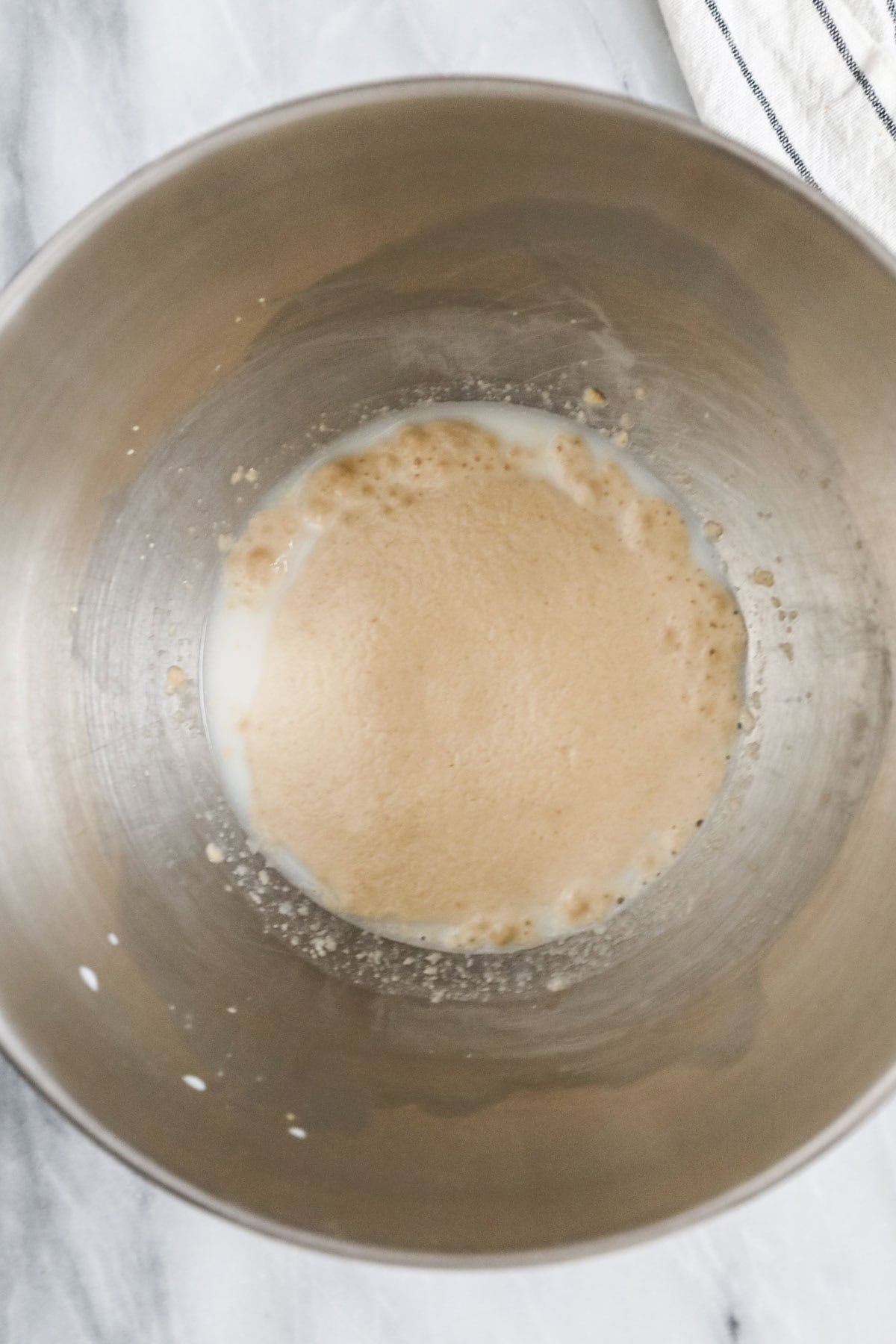
Add the yeast and a pinch of sugar to the warm milk and water. Let this mixture sit for a few minutes until it becomes foamy. I do this step regardless of whether I’m making the naan with active or instant yeast, while instant yeast doesn’t have to be activated this way, it’s easiest to keep the recipe the same regardless of the yeast you have on hand.
Note: if your yeast never foams, it is likely dead and you will need to start over. Make sure you use fresh yeast and heat your water and milk to the proper temperature to avoid this.
Knead & first rise
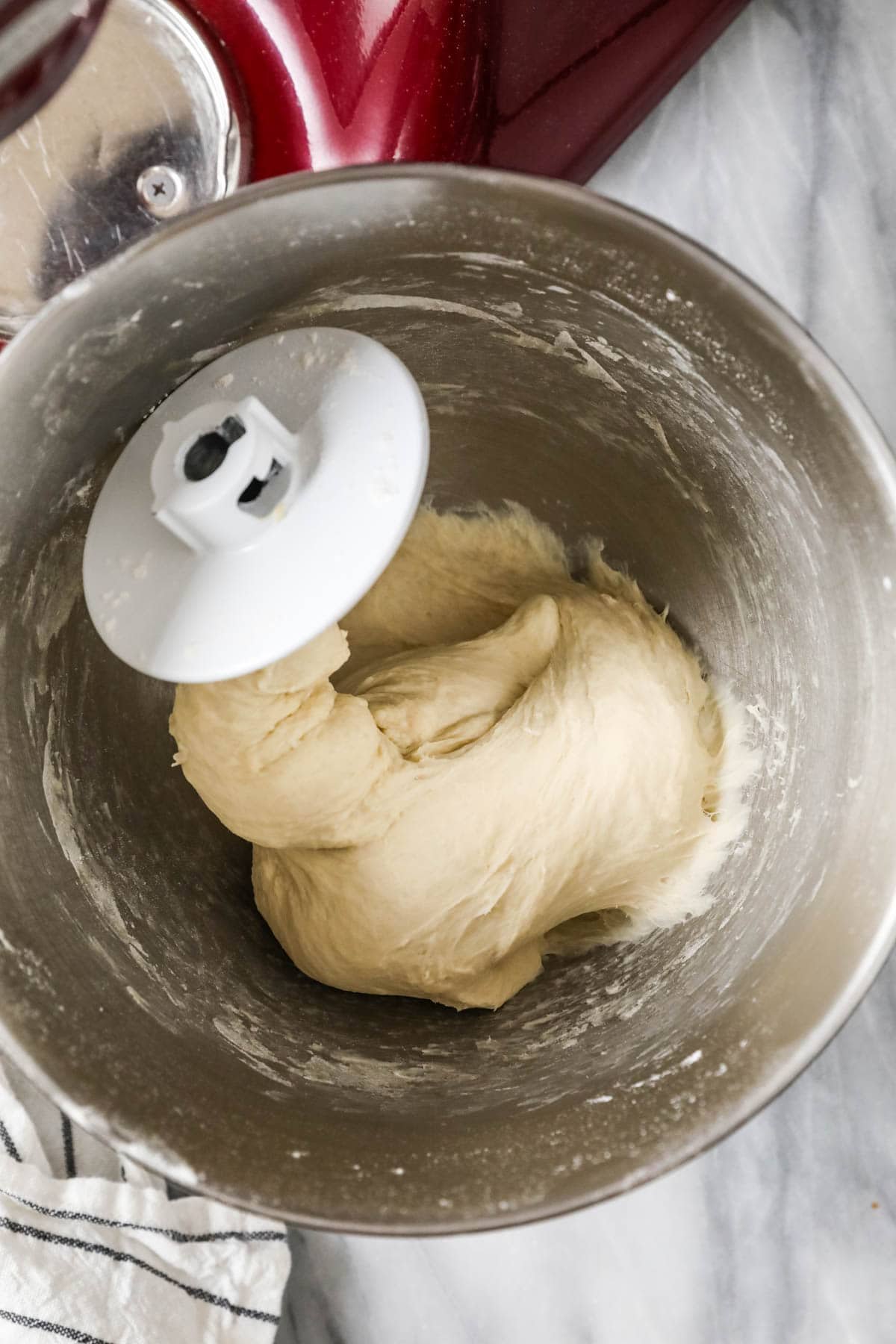
Add the sugar, baking powder, salt, yogurt, oil, garlic (if using) and the first round of flour. Stir this until well combined, then add the second cup of flour gradually–you may not need it all, or you may need more. You’ll know you’ve added enough when the dough starts to cling to itself and pulls away from the sides of the bowl.
Knead the dough using either a stand mixer and dough hook or your hands. Keep kneading until the dough is smooth and cohesive (it may still be sticky–this is good!), then transfer to a lightly oiled bowl. Let rise in a warm spot until doubled in size.
Divide & second rise
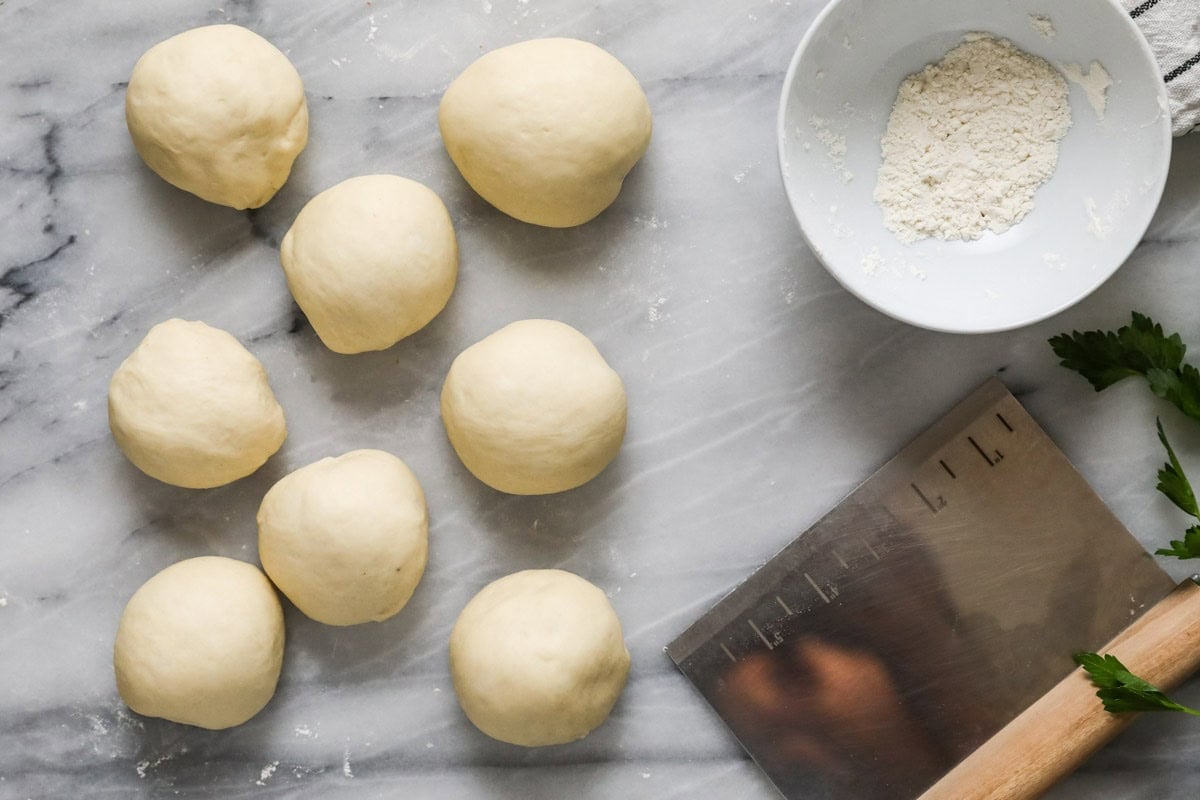
Divide the dough into 8 pieces, then roll each piece into a smooth ball.
Cover lightly with a piece of plastic wrap and let the dough balls rise again until slightly puffed, this will only take about 10-15 minutes (unless your kitchen is quite cold, then it might take a bit longer!). I’ve found that it only takes about 10-15 minutes for the dough to complete its second rise regardless of whether you’re using instant/rapid rise or active dry yeast.
Roll & cook
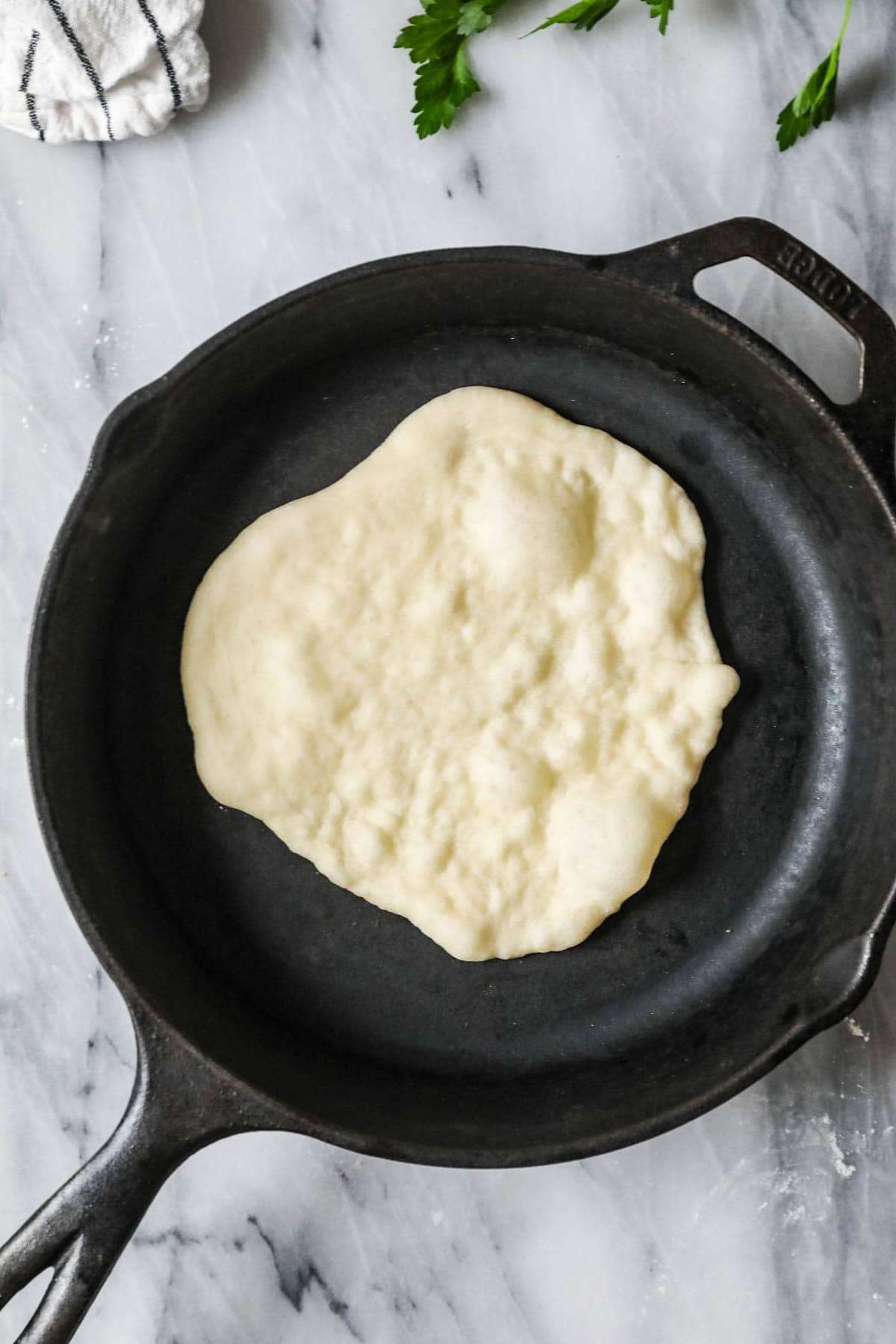
Preheat your cast iron so it gets nice and hot (a hot pan is critical for proper results!). While this is heating, roll out your first piece of naan. Don’t roll the naan too thin; you want it to have some thickness to it (it’s not a tortilla!). If you follow the dimensions listed you won’t have any issue.
Place in your pan (I do not grease the pan) and let cook on the first side. Watch for bubbles and browning to happen before flipping. I provide time guidelines, but this will vary depending on your exact stovetop heat. Flip over and cook until finished, about 30-60 seconds more. I typically work with just one, sometimes two pieces at a time depending on the size of my pan.
Brush with butter immediately after cooking, or better yet use the garlic butter topping below…
Garlic Butter Naan Topping
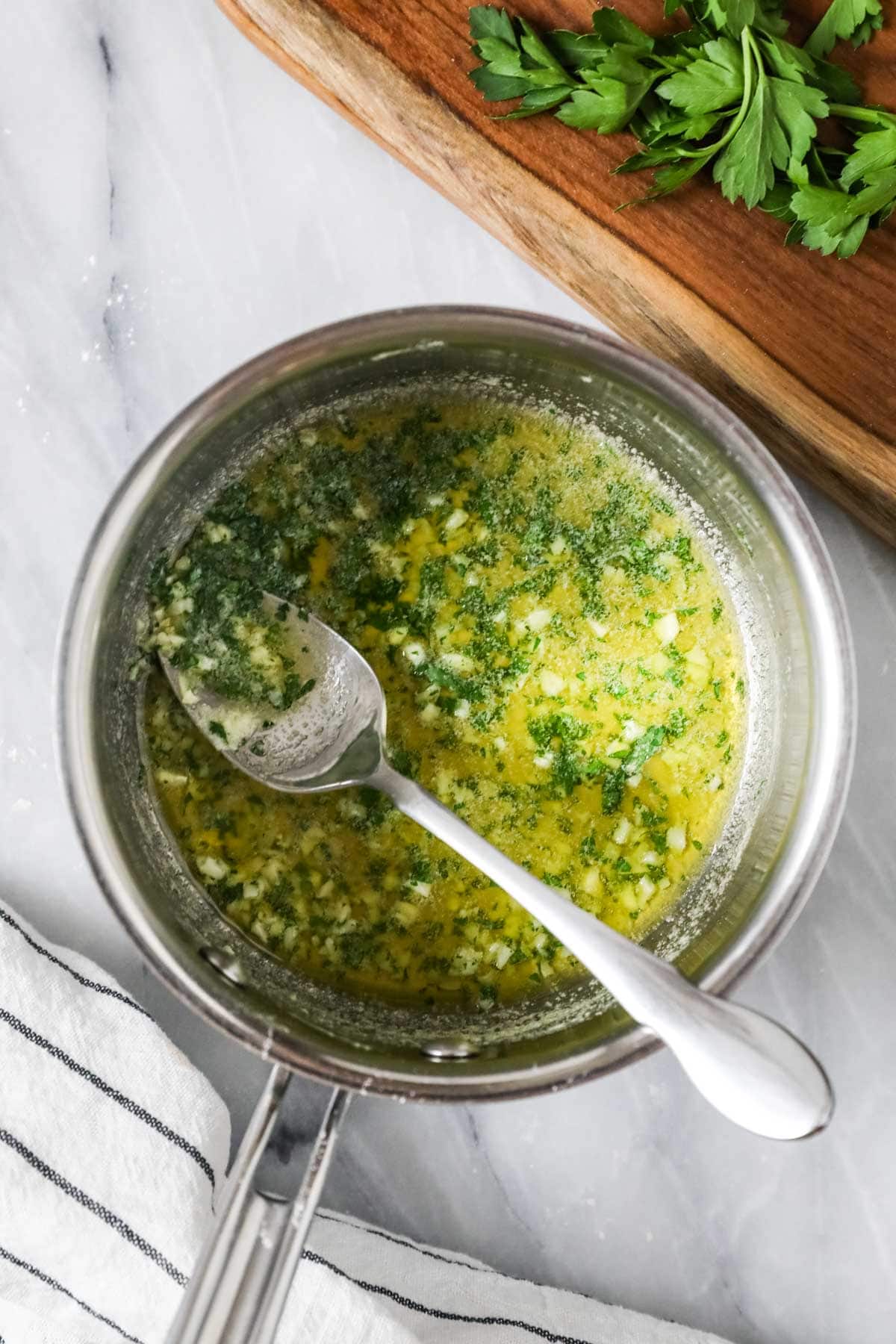
This topping is optional, but it’s so easy to make and, well, once you try it you won’t ever want naan without it (especially if you’re making garlic naan!). To make it, simply melt some butter in a saucepan, then toss in some fresh minced parsley and garlic. Let this cook for a few minutes until it smells amazing, then brush over your warm naan.
Also, if you like this topping, you will also like my garlic knots–they have a very similar topping 😋
SAM’S TIP: Just like when making pancakes, you can keep your cooked naan warm in a very low oven. I like to use the “warm” setting on my oven, but if yours doesn’t have that, just set it to its lowest setting.
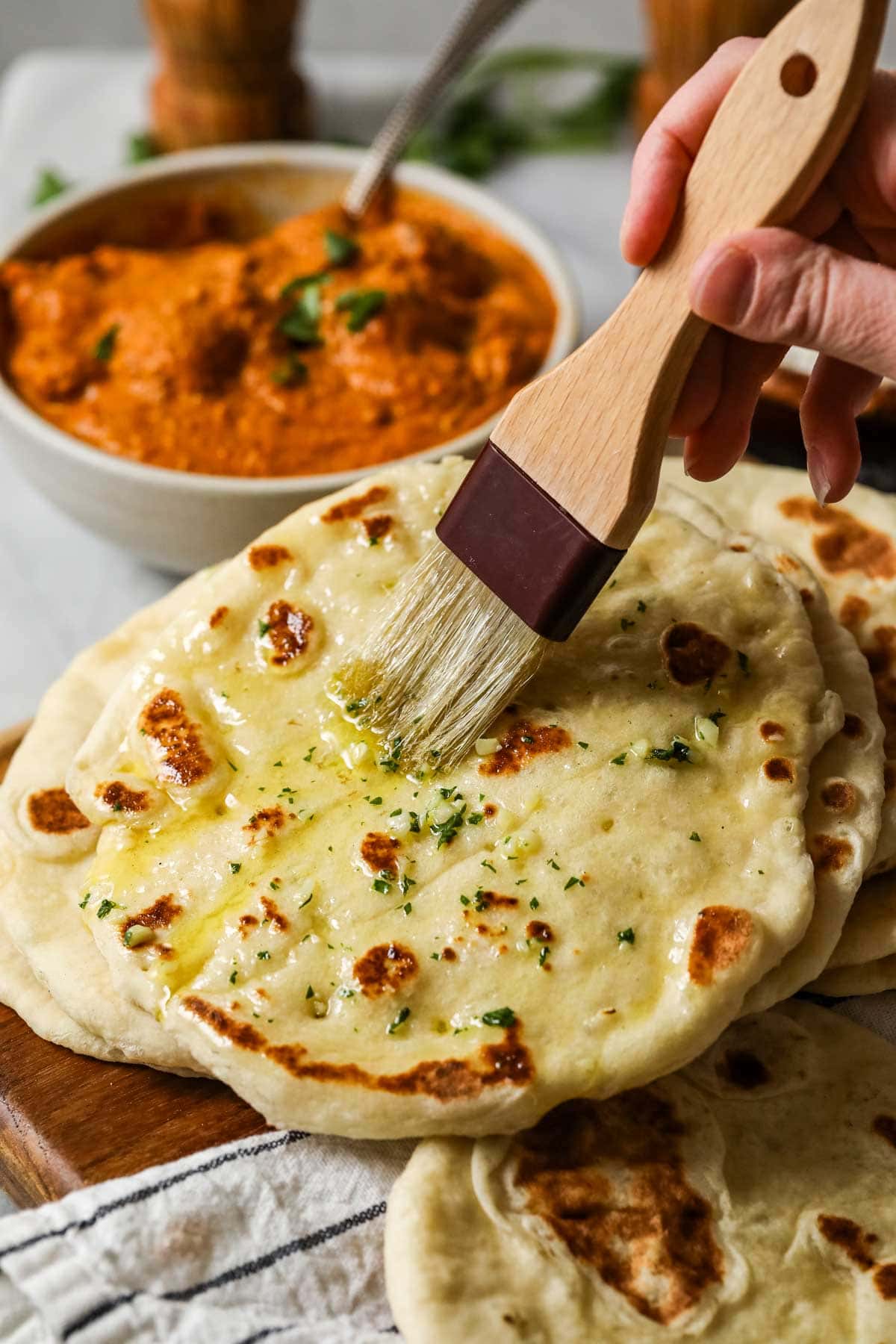
Frequently Asked Questions
If naan is tough, it most likely was cooked too much. You really only need to heat it until just cooked through, at most two minutes, as long as your pan is nice and hot.
Reheating your naan for too long can also cause this, so only reheat for a few minutes.
Yes! You can make it a few days ahead of time or even freeze it for a few months. This is especially helpful if you plan to make your butter chicken or tikka masala from scratch as well–I usually like to keep some naan in the freezer so I don’t have to make it all the same day.
I include detailed instructions for storage, freezing, and reheating in the recipe notes below.
A cast iron pan most closely resembles the traditional tandoor cooking method for home cooks. You can use a stainless steel pan or whatever pan you do have, but just know that you may not get that traditional blistered look without a cast iron pan.
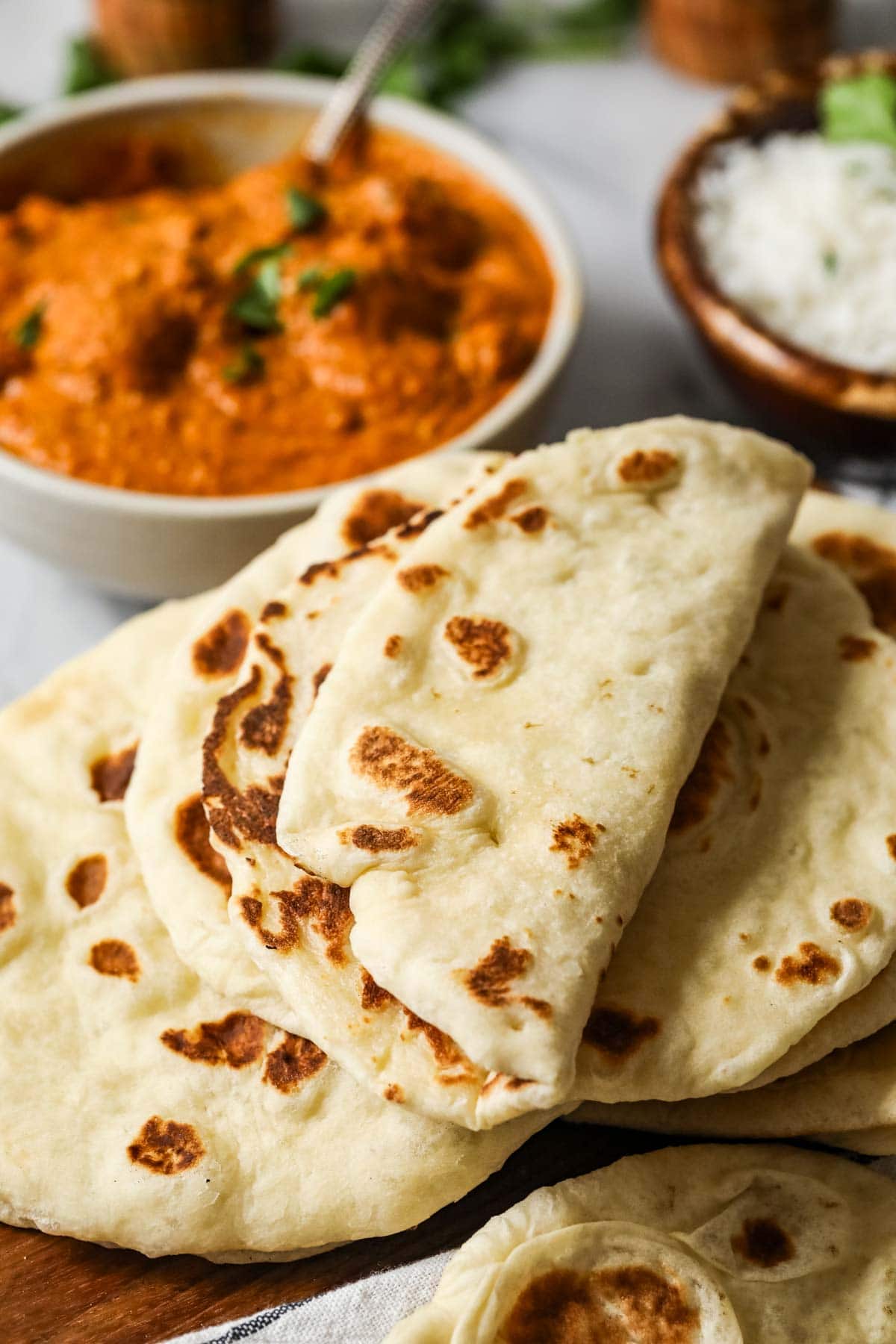
I know this recipe is a bit different from my usual content–would you like to see more like this? Leave me a comment below and let me know!
Also, stay tuned for my butter chicken recipe coming very soon 🤗
Enjoy!
Let’s bake together! Subscribe to my newsletter to be notified of all the newest recipes, and find my free recipe tutorials on YouTube 💜
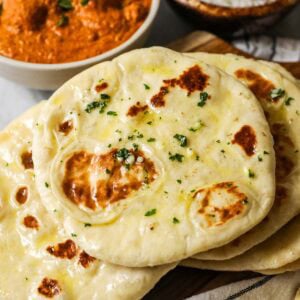
Naan
Soft and chewy with a charred, bubbly exterior, this homemade naan recipe rivals that of your local Indian restaurant! A hot cast iron pan is key for replicating the traditional tandoor cooking method at home.
Print
Pin
Rate
Prevent your screen from going dark
Servings: 8 servings
Calories: 239kcal
Ingredients
For topping (optional but so good!)
Instructions
Make the dough
-
In a microwave safe dish, warm water and milk until it reaches 100F (38C) (always stir before checking temperature).
½ cup (120 ml) water, 3 Tablespoons milk
-
Pour warmed liquid into the bowl of a stand mixer (or a large mixing bowl), add yeast and a pinch of sugar and stir to combine. Let sit for 5-10 minutes until mixture becomes foamy (if it never foams, you’ll need to start over with fresh yeast).
2 teaspoons active dry yeast*
-
Once foamy, add about 1 ½ cups (188g) bread flour, sugar, baking powder, salt, Greek yogurt, olive oil, and garlic (if making garlic naan) and stir until well-combined.
2 teaspoons granulated sugar, ¾ teaspoon baking powder, ¾ teaspoon table salt, ¼ cup (60 g) full fat Greek yogurt, 2 Tablespoons olive oil, 2 teaspoons minced garlic
-
Gradually stir in the remaining 1 cup (125g) flour until dough begins to cling to itself and pull away from the sides of the bowl.
-
Place bowl on your stand mixer and, using dough hook attachment, knead on low-speed for 4 minutes (alternatively turn the dough out onto a lightly floured surface and knead by hand for about 5 minutes). Knead until dough is cohesive and no longer shaggy (it still may be slightly sticky/tacky, especially if you used the stand mixer – this is good!). Note that this dough does not become completely smooth and elastic like many yeast breads nor will it pass the “windowpane test”.
-
Transfer dough to a large, lightly oiled bowl and turn to coat all sides with oil. Cover with plastic wrap and allow to rise in a warm space until doubled in size, about 1-2 hours.
Roll & bake
-
Once dough has risen, turn out onto a lightly floured surface and divide into 8 equal pieces. Roll each piece into a ball, stretching and tucking the edges underneath if necessary to create a ball shape. Cover with plastic wrap and let rise for 10-15 minutes until slightly puffed.
-
Heat your cast iron skillet over medium/high heat for at least 5 minutes (you should be able to feel the heat radiating from it if you hover your hand a few inches above it).
-
Once skillet is heated and dough has risen, working with one ball at a time, roll dough out into a 6-8” (15-20cm) circle.
-
Carefully place circle (just one or two at a time, depending on the space in your skillet) into your heated skillet and heat on one side for about 45-60 seconds, until bubbles start to form. Flip over and cook until naan is cooked through, this will usually take another 30-60 seconds.
-
Remove naan to a plate, and repeat until all naan is cooked. Prepare the topping
Garlic butter topping
-
In a small saucepan, melt butter over low heat.
4 Tablespoons (57 g) salted butter
-
Add parsley and garlic (if making garlic naan) and stir to combine. Cook several minutes, until fragrant.
1 Tablespoon chopped fresh parsley, 2 teaspoons minced garlic
-
Use a pastry brush to brush topping over warm, cooked naan. Enjoy!
Notes
Instant yeast
To use instant yeast, substitute 1 ½ teaspoons instant yeast and follow the recipe as written. Rise time will be the same or very similar as when using active yeast.
Flour
I prefer bread flour for a chewier naan, but all-purpose flour will work in a pinch.
Storing
Allow to cool completely and place in an airtight container or resealable ziploc bag. Refrigerate for 2-3 days or freeze (I wrap the naan individually in plastic wrap first if freezing) for 1-2 months.
To reheat, warm in a 325F (160C) oven for several minutes, until warmed through.
Nutrition
Serving: 1serving | Calories: 239kcal | Carbohydrates: 32g | Protein: 5g | Fat: 10g | Saturated Fat: 4g | Polyunsaturated Fat: 1g | Monounsaturated Fat: 4g | Trans Fat: 0.2g | Cholesterol: 16mg | Sodium: 300mg | Potassium: 77mg | Fiber: 1g | Sugar: 2g | Vitamin A: 227IU | Vitamin C: 1mg | Calcium: 53mg | Iron: 2mg
Nutritional information is based on third-party calculations and should be considered an estimate only. Actual nutritional content will vary based upon brands used, measuring methods, cooking method, portion sizes, and more.

